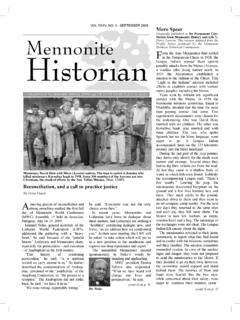Transcription of Mennonite Refugee Camps in Germany, 1921-1951: Historian I
1 August Liebig, portrait, memorial, and tombstone. Photo credit: Abe and Gerry Friesen. August G. A. Liebig and his North American Legacy1 by Abe J. Dueck ennonite Brethren historians have long noted the role of August G. A. Liebig (1836-1914) in the early evolution of the Mennonite Brethren Church in Russia. The fledgling movement was strongly influenced by German Baptist leaders. First, there was Gerhard Oncken, the founder of the German Baptists based in Hamburg, who visited the Mennonite Brethren in 1869. Then, even more importantly, August Liebig was invited by some of the early leaders and came in 1866 to spend several weeks to help bring order to the movement, after the turmoil of the so-called exuberant movement (Froeliche Richtung). In 1871, Liebig took up residence in Andreasfeld, Chortitza and remained for an entire year.
2 It was partly as a result of his counsel that regular patterns of congregational meetings and conferences were organized. In 1872, Mennonite Brethren were the first to organize into a conference with annual conventions. The larger body of Mennonites (often referred to as Kirchengemeinden) had established an informal structure known as a Kirchenkonvent, which consisted of church leaders (Alteste and Lehrer). But not until 1883 did they establish a General Conference (Allgemeine Bundeskonferenz der Mennonitenge-meinden in Russland).2 August Liebig was one of five Liebig brothers, who were very active in ministry in various regions in Europe and The others were Friedrich Wilhelm, Leopold, Hermann, and Helmut. August, the third brother, was born on February 14, 1836 in Bernstein, Neumark, Prussia.
3 He was converted in 1856. He began his missionary ministry in Bucharest, Romania in 1863. From there, he traveled widely into Turkey and southern Russia. In 1874, he took up residence in Odessa. (cont d on p. 6) Mennonite Refugee Camps in Germany, 1921-1951: Part I Lager Lechfeld by Peter Letkemann (Winnipeg) n November 1920 German Mennonite leaders met in the city of Ludwigshafen on the Rhine to establish the Menno-nitische Fl chtlings-F rsorge [MFF] Men nonite Refugee Aid organisation (renamed Deutsche Mennoniten-Hilfe [DMH] in May 1922). Its immediate aim, as the name implies, was to provide assistance to the hundreds of Mennonite refugees who had fled from Soviet Russia and Ukraine to Germany since 1918. The movement of Russian Mennonites to Germany began during the time of the German occupation of Ukraine from February to November 1918.
4 Many Mennonites, especially wealthier and connected Mennonites (including Jo-hann Esau, the former mayor of Ekaterinoslav, now Dnepropetrovsk), left Ukraine with the retreating German forces after the German surrender at Compiegne in November 1918. Others fled secretly and illegally across Russia s and Ukraine s western borders into the newly founded Republic of Poland and from there into Germany. Once in Germany, some were able to find refuge with family or friends, but most ended up in displaced persons Camps scattered throughout the country housed in cramped, poor conditions along with thousands of other German refugees from the East, from former German and Austrian lands that had been lost to Poland, Russia and Romania at Versailles in 1919. As a result of limitations imposed by this treaty on Germany s armed forces limiting them to a maxi-mum of 100,000 men dozens of military establishments, barracks and training centres had to be closed and vacated.
5 Leaders of the MFF met with representatives of the Prussian and Bavarian governments in 1920 to negotiate a lease for the abandoned military Camp Lechfeld, located in Bavaria, about 20 km south of Augsburg. The deal was finalized in April 1921, and the first Mennonite refugees began arriving in May-June 1921. The Lechfeld military base was established by the Bavarian government in the 1850s as an artillery practice range during the Crimean War. After that war, the camp was expanded to include barracks and troop training facilities. (cont d on p. 2) M I VOLUME 38, NO. 3 - SEPTEMBER 2012 Historian Mennonite A PUBLICATION OF THE Mennonite HERITAGE CENTRE and THE CENTRE FOR MB STUDIES IN CANADA Page 2 September 2012 Mennonite Historian Lechfeld Camp (cont d from p. 1) During the Franco-Prussian War of 1870 -71, Lechfeld was used as a POW camp for French prisoners.
6 Later, during World War I, it housed prisoners captured on the eastern Russian Front. In the first decade of the 20th century it also became home to one of the first aerial training Camps of the newly founded German air force. Among the pilots trained here at that time was Rudolph Hess, later deputy F hrer to Adolf Hitler. Hitler himself was stationed for a short time in Lechfeld in 1917-18, after he volunteered for service in a Bavarian Infantry Unit. After the First World War, all POWS kept in Lechfeld were repatriated and the barracks were used temporarily to house German soldiers being demobilized. After the signing of the Treaty of Versailles (1919), military hardware and airplanes were dismantled and aircraft hangars destroyed. Reverend Michael Horsch and other South-German Mennonites living in the vicinity felt the camp could be used to house Mennonite refugees, and to start a small farming operation and craft centre.
7 Horsch became the first farm manager, but was replaced by Philipp Lichti in January 1922 due to a variety of difficulties. This occurred during a time of economic crisis and severe inflation in Germany, and the camp was beset with financial woes from the start. The new Mennonite residents also complained. They were glad to have gotten out of Russia, but were impatient to emigrate to Canada, whose doors were still closed at the time to Mennonite immigration. When the first wave of legal Mennonite migration from the Soviet Union began in the summer of 1923, the facilities at Camp Lechfeld were enlarged to provide temporary housing for these new Mennonite immigrants as well. Theodor Block (himself a Mennonite Refugee from the Molochna) was appointed as director of the new Durchgangslager (Transit Camp).
8 Because of Canada s strict medical policies, no person with communicable diseases, such as trachoma or typhus, was allowed entry to Canada. These individuals, and sometimes their entire families, then had to be housed and provided with medical treatment at Lech- Army barracks in Lechfeld feld before they were allowed to leave for Canada. Throughout these years from 1921-1926, the aid operation was constantly beset by squabbles among German Mennonite leaders. As the emigration wave subsided and dried to a trickle by late 1926, these leaders ultimately decided to liquidate the operation and transfer all remaining emigrants to the processing centre in the Atlantic Park Hostel in Southampton, England. At this time, Benjamin H. Unruh was appointed by the Canadian Mennonite Board of Colonization to supervise this program.
9 The Lechfeld camp and the MFF/DMH was officially liquidated in November 1926, but disagreements between German Mennonite leaders over how to deal with the remaining assets, and how to apportion the large outstanding debts, led to an accounting and legal quagmire that dragged on for another 6 years until 1932 (longer than the camp itself had been in operation!). The Lechfeld episode showed Mennonites at their best but also at their worst! Postscript: Camp Lechfeld found new life in 1933 when the National Socialists came to power in Germany. It became one of the centres of the newly formed German Luftwaffe, especially because of its proximity to the large Messerschmitt Aircraft facilities in nearby Augsburg, and an important training facility for combat pilots and for testing new fighter aircraft. In late 1936, test pilots in Lechfeld set the world speed record a record that stood until the early 1950s, when Chuck Yeager broke the sound barrier in New Mexico.
10 During World War II the airbase was attacked repeatedly and finally destroyed completely by American bombers in 1945. But after the re-establishment of the German Bundeswehr and Luftwaffe in the early 1950s, Lechfeld became the headquarters of a large German bomber squadron. It remains in use today as a German and NATO training facility. The day I visited the camp in June 2010, NATO Tornado jet fighters screamed overhead, performing precision laser-guided bombing runs in preparation for their deployment in Afghanistan. For a time Mennonites were able to turn swords into ploughshares, [Philipp Hege and Abraham Warkentin, Das Schwert zur Pflugschar, Gemeindeblatt der Mennoniten, 52. Jg. Nr. 11 (1 Jun 1921), 51] as this large military establishment was converted into a humanitarian aid centre in the 1920s; but in the end, the ploughshares were again fashioned into even larger and more deadly swords.










